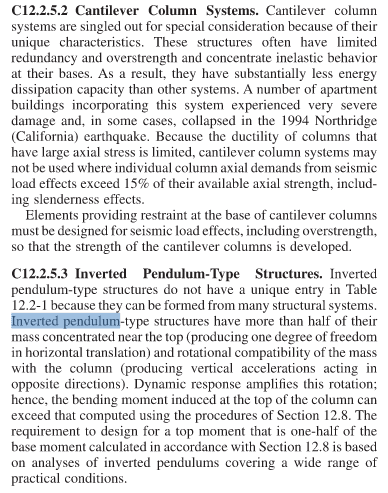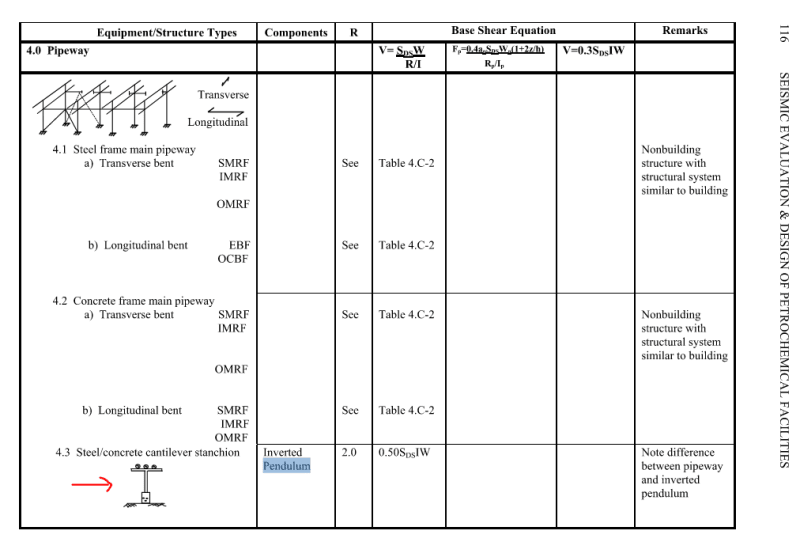Hello All
I am writing to seek clarification in ASCE 7 Inverted Pendulum Structures vs cantilever column systems and discuss/seek answers to questions on (2) real world scenario I am facing. Inverted Pendulum type Structures are defined in chapter 12.2.5.3. The commentary C12.2.5.3 states it can be formed from many structural systems:

1) What kind of "many systems" is it referring to in the commentary C12.2.5.3 of ASCE 7?
2) If a cantilevered steel column in question is in a ordinary residential or commercial building structure (for occupants), then it would be classified as a steel special or ordinary cantilever column system per table 12.2.1 but C12.2.5.3 makes it sound like you can use categorize this as an inverted pendulum type structure (provided it meets the definition of inverted pendulum structure). If that is possible, you are then exempt from using over strength factor for base plate and foundation design that you would otherwise do for a special cantilever column or even meet the 15% axial load requirement in place for cantilever columns. This open ended provision does not make sense to me. Any thoughts? To supplement that why would the inverted pendulum structures not require overstrength factors for base and foundation as they are also non-redundant like cantilever columns?
Furthermore, seismic coefficients for inverted pendulum are specified in Table 15.4.2 (Non-Building Structures Not Similar to Buildings) but not in Table 15.4.1 ( Non-Building Structures similar to buildings)
3) Structure 1 (Real case): A few cantilevered steel columns are part of an industrial structure that is supporting an equipment (so Non-building Structure). This structure has a few steel braced frames in one direction, a couple of steel moment frames in the other direction. Now, the columns that are part of the moment frames or braced frames are cantilevered in the direction where frame action is absent. Additionally, I have a few cantilever columns that are standalone and not part of any frames ( no interaction with the frames so no dual system present at this time). Presence of all the moment frames and braced frames makes the structure a Non-building structure that is similar to buildings, correct? That means Table 15.4.2 and not Table 15.4.1? Does that mean I cannot use inverted pendulum structures for the cantilevered columns and I have to use steel special cantilever column per Table 12.2.1?
4) Structure 2 (Real Case): Similar to Structure 1 except no frames present. Only Steel beams and steel columns. Columns pinned at top and fixed at the base. Structure supports equipment (Non-Building Chapter 15). would this type of structure be classified as a "non-building structure not-similar to buildings" and consequently use inverted pendulum in Table 15.4.2?
5) Finally, what is worse: Cantilever column system or Inverted pendulum system design and costwise as required by ASCE-7. I think cantilever column system are worse because of AISC 341 detailing requirements, amplification of forces for base plate and foundation, and 15% axial stress limit requirement. What do you think?
Very sorry for the elaborate message. I would truly appreciate all the inputs I can get!
I am writing to seek clarification in ASCE 7 Inverted Pendulum Structures vs cantilever column systems and discuss/seek answers to questions on (2) real world scenario I am facing. Inverted Pendulum type Structures are defined in chapter 12.2.5.3. The commentary C12.2.5.3 states it can be formed from many structural systems:

1) What kind of "many systems" is it referring to in the commentary C12.2.5.3 of ASCE 7?
2) If a cantilevered steel column in question is in a ordinary residential or commercial building structure (for occupants), then it would be classified as a steel special or ordinary cantilever column system per table 12.2.1 but C12.2.5.3 makes it sound like you can use categorize this as an inverted pendulum type structure (provided it meets the definition of inverted pendulum structure). If that is possible, you are then exempt from using over strength factor for base plate and foundation design that you would otherwise do for a special cantilever column or even meet the 15% axial load requirement in place for cantilever columns. This open ended provision does not make sense to me. Any thoughts? To supplement that why would the inverted pendulum structures not require overstrength factors for base and foundation as they are also non-redundant like cantilever columns?
Furthermore, seismic coefficients for inverted pendulum are specified in Table 15.4.2 (Non-Building Structures Not Similar to Buildings) but not in Table 15.4.1 ( Non-Building Structures similar to buildings)
3) Structure 1 (Real case): A few cantilevered steel columns are part of an industrial structure that is supporting an equipment (so Non-building Structure). This structure has a few steel braced frames in one direction, a couple of steel moment frames in the other direction. Now, the columns that are part of the moment frames or braced frames are cantilevered in the direction where frame action is absent. Additionally, I have a few cantilever columns that are standalone and not part of any frames ( no interaction with the frames so no dual system present at this time). Presence of all the moment frames and braced frames makes the structure a Non-building structure that is similar to buildings, correct? That means Table 15.4.2 and not Table 15.4.1? Does that mean I cannot use inverted pendulum structures for the cantilevered columns and I have to use steel special cantilever column per Table 12.2.1?
4) Structure 2 (Real Case): Similar to Structure 1 except no frames present. Only Steel beams and steel columns. Columns pinned at top and fixed at the base. Structure supports equipment (Non-Building Chapter 15). would this type of structure be classified as a "non-building structure not-similar to buildings" and consequently use inverted pendulum in Table 15.4.2?
5) Finally, what is worse: Cantilever column system or Inverted pendulum system design and costwise as required by ASCE-7. I think cantilever column system are worse because of AISC 341 detailing requirements, amplification of forces for base plate and foundation, and 15% axial stress limit requirement. What do you think?
Very sorry for the elaborate message. I would truly appreciate all the inputs I can get!

